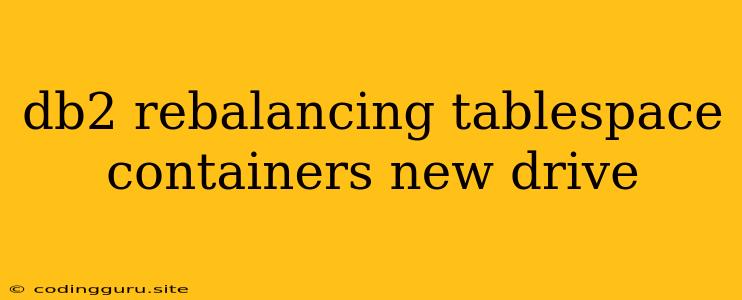Rebalancing Tablespace Containers to a New Drive in DB2
Need to move your DB2 tablespace containers to a new drive? Rebalancing your tablespace containers is a common task that arises when you need to optimize storage space, improve performance, or simply migrate to a different drive. This process involves moving the data and log files associated with your tablespaces to a new location. While seemingly straightforward, it requires careful planning and execution to avoid downtime and data loss.
Why Rebalance Tablespace Containers?
There are several reasons why you might want to rebalance your tablespace containers:
- Storage Space Optimization: As your database grows, you might run out of space on your existing drive. Rebalancing your containers to a new, larger drive can alleviate this issue.
- Performance Enhancement: Moving tablespace containers to a faster drive can significantly improve the performance of your database. This is particularly helpful for frequently accessed data.
- Drive Migration: You might need to move your data to a new drive, for example, after replacing a faulty drive or upgrading to a different storage solution.
- Data Locality: In a distributed environment, placing tablespace containers on the same drive as the applications accessing them can optimize I/O operations.
Steps to Rebalance Tablespace Containers in DB2
Here's a step-by-step guide to rebalancing your tablespace containers:
1. Plan Your Strategy:
- Identify the Tablespaces: Determine which tablespaces you need to rebalance.
- New Drive Setup: Ensure the new drive is properly configured with appropriate storage space and permissions.
- Data Backup: Always take a full backup of your database before starting the rebalancing process. This will act as a safety net in case of any unexpected issues.
- Downtime Management: If possible, schedule the rebalancing process during off-peak hours to minimize downtime for your applications.
2. Create New Tablespace Containers on the New Drive:
- Define the New Location: Use the CREATE TABLESPACE command to specify the new location for the containers.
- Specify the Size: Define the size and number of containers for your tablespaces.
- Allocate Disk Space: The database administrator should allocate enough disk space for the new tablespace containers.
3. Migrate Tablespace Data:
- Use the ALTER TABLESPACE Command: Use the ALTER TABLESPACE command to move the data from the old tablespace containers to the newly created ones.
- Specify the Container Locations: Make sure to specify the new container locations in the command.
- Incremental Migration: For large tablespaces, consider using incremental migration options to minimize downtime. This involves migrating data in smaller chunks, minimizing the impact on ongoing database operations.
4. Verify the Data Integrity:
- Check Data Consistency: After the rebalancing process is complete, carefully verify the data integrity of your tablespaces.
- Run Data Verification Utilities: DB2 provides utilities like REORG and CHECK DATA that can help you validate the data in your tablespaces.
5. Remove Old Tablespace Containers:
- Deallocate Disk Space: Deallocate the disk space occupied by the old tablespace containers.
- Delete Old Tablespace Definitions: Remove the old tablespace container definitions from the database using the DROP TABLESPACE command.
Tips for Successful Rebalancing
- Test Before Production: Always test the rebalancing process on a development or test environment before implementing it in production. This helps ensure that everything works as expected and prevents unforeseen issues.
- Monitor Progress: Closely monitor the rebalancing process to identify and resolve any issues that may arise.
- Consider Parallelism: If your DB2 environment allows, consider using parallelism to speed up the data migration process.
- Document the Process: Maintain detailed documentation of the rebalancing process for future reference and to facilitate troubleshooting.
Examples and Scenarios
Scenario 1: Moving a tablespace to a new drive with more capacity.
-- Create a new tablespace container on the new drive:
CREATE TABLESPACE TS_NEW_DRIVE
DATA (
CONTAINER ( '/mnt/newdrive/ts_container1', 1000 ),
CONTAINER ( '/mnt/newdrive/ts_container2', 1000 )
);
-- Move the existing tablespace to the new container:
ALTER TABLESPACE TS_OLD_DRIVE
MOVE DATA TO (
CONTAINER ( '/mnt/newdrive/ts_container1', 1000 ),
CONTAINER ( '/mnt/newdrive/ts_container2', 1000 )
);
Scenario 2: Splitting a tablespace into multiple containers on different drives.
-- Create a new tablespace container on the second drive:
CREATE TABLESPACE TS_NEW_DRIVE
DATA (
CONTAINER ( '/mnt/newdrive/ts_container1', 1000 ),
CONTAINER ( '/mnt/newdrive/ts_container2', 1000 )
);
-- Move half of the data to the new drive:
ALTER TABLESPACE TS_OLD_DRIVE
MOVE DATA TO (
CONTAINER ( '/mnt/newdrive/ts_container1', 500 ),
CONTAINER ( '/mnt/newdrive/ts_container2', 500 )
);
Scenario 3: Moving tablespace containers to a new drive while maintaining data integrity.
-- Create a new tablespace container on the new drive:
CREATE TABLESPACE TS_NEW_DRIVE
DATA (
CONTAINER ( '/mnt/newdrive/ts_container1', 1000 ),
CONTAINER ( '/mnt/newdrive/ts_container2', 1000 )
);
-- Migrate the tablespace data:
ALTER TABLESPACE TS_OLD_DRIVE
MOVE DATA TO (
CONTAINER ( '/mnt/newdrive/ts_container1', 1000 ),
CONTAINER ( '/mnt/newdrive/ts_container2', 1000 )
);
-- Verify data integrity:
CHECK DATA FOR TABLESPACE TS_NEW_DRIVE;
Conclusion
Rebalancing tablespace containers in DB2 is a crucial task for database administrators seeking to optimize storage, performance, and data locality. The process requires careful planning, execution, and verification to ensure data integrity and minimize downtime. By following these steps and incorporating best practices, you can successfully move your tablespace containers to a new drive while maintaining the health and efficiency of your database. Remember to always test before production, monitor progress, and document your rebalancing process for future reference.
